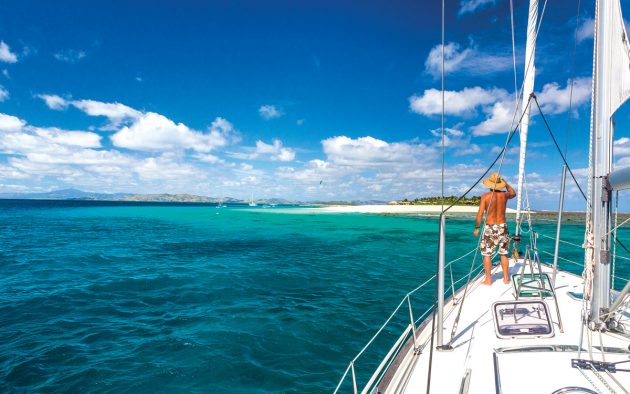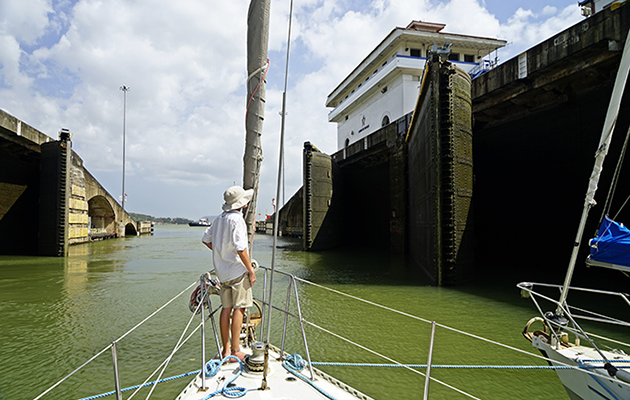Immense and diverse, the expanse of the Pacific offers some of the finest tradewinds cruising you’ll ever experience and a wealth of friendly cultures. Dan Bower explains how to prepare and where to sail
A cruising sailor’s blog, newsfeed or Instagram account from the Pacific is an onslaught of images and videos of every flavour of paradise from the green, dramatic and rugged landscape of the Marquesas with its huge waterfalls, the coral atolls and blue lagoons of the Tuamotus, to Tahiti and Bora Bora, the volcanic eruptions and cauldrons of lava in Vanuatu, the breaching whales of the Coral Sea… Enough already, as they say!
The Pacific Ocean is by far and away the most diverse for cruising. The scenery and culture varies between each country but everywhere there is a welcoming and genuine hospitality – and the sailing is excellent.

It pays to pick your route carefully
What to expect when sailing across the Pacific
When examining planning charts and contemplating sailing the Pacific Ocean, it looks huge. It is 8,000 nautical miles from Panama to Australia (you can cross the Atlantic in 2,200 miles) and, because of the scale of the charts and the size of the islands, it appears to have little land. But zoom in on the chartplotter and the islands and island groups are plentiful.
You must make one very long crossing, the 3,000 miles from the Galapagos Islands to the Marquesas, but this is usually fast sailing with a favourable current bringing the passage time down to one similar to a transatlantic crossing. We’ve made this Pacific passage three times, and we reckon it’s easier sailing than on an average ARC. There has been less swell, more regular winds and no squalls, and after you arrive in the Marquesas you’re rarely more than four days from your next destination.
Article continues below…
Bluewater Sailing Techniques Part 1: introducing our 12-part series with a cruise in the Pacific
We begin our new 12-part multimedia series on Bluewater Sailing Techniques in stunning Fiji
Through the Panama Canal in your yacht: everything you need to know
Cape Horn sailors and ditch diggers sacrificed all to make the path between the Atlantic and Pacific easier for the…
With an eye on the weather there are plenty of protected anchorages throughout the Pacific, and there are all-weather ports in most island groups.
But sailing across the Pacific is not without its challenges. There are tricky coral passes to negotiate, and it helps to speak French, but time spent preparing and planning can help make it plain sailing and, in my experience, the cruise of a lifetime.
Sailing through the Panama Canal
When you enter the Pacific from the Panama Canal you can feel this is a different ocean. The blue, warm waters of the Caribbean are replaced with the decidedly chilly, much darker nutrient-rich ones brought from Antarctica borne by the Humboldt Current. Its favourable effects can be felt under your keel as you head towards the Galapagos, and make for a bracing first swim. The 6m tidal range can also come as a bit of a shock.
Choosing your route
The passage to the Galapagos should pose no major problems but you will probably have to sail through The Doldrums and you will cross the equator. The national park in the Galapagos is sensitive to foreign species and so you can expect to have all your fresh food removed when you arrive. The authorities also don’t like any growth on your hull – they can turn you away or make you go out of the park to have your hull cleaned (an 80-mile round trip), so it’s worth pressure washing in Panama and getting all through-hull fittings thoroughly cleaned if you’re unsure.

Brochure cruising in the turquoise, sheltered water of a typical French Polynesia atoll
From here you depart on the main passage to the Marquesas Islands and ahead the expanse of French Polynesia opens up. This ocean leg is the Pacific Ocean proper, with approximately 3,000 miles of what should be tradewind sailing at its best, a mile-melting broad reach and an equatorial current beneath you. Depending on the position of the Inter Tropical Convergence Zone (ITCZ) you may be able to sail down the rhumb line or, if not, head a bit further south for more stable conditions.
Arriving in the Marquesas is a pleasurable culture shock and is as dramatic socially as it is scenically. Away from the small towns it is a great place to cruise to quiet bays with beautiful beaches, trade odds and ends with the locals for the most delicious fruit and explore the interior with its wonderful waterfalls and archaeological remains.
Once you’ve had your fill of green and lush beauty (yes, it rains) and have filled the boat with Pomello grapefruit, mangoes, coconuts and pineapples, it’s time to push off to the Tuamotus. The hardest part about this leg is deciding where to go – there are 80 atolls to choose from.

Coral snorkelling is a must
Sailing the South Pacific
On arrival you need to get the tide times right to navigate a narrow pass, but the reward is a calm, clean and incredibly blue lagoon. Snorkelling is the highlight here and the lagoons are home to the prettiest and most diverse coral I have ever seen. The adventurous can drift snorkel through the passes on an incoming tide, and you can effortlessly glide amongst sharks and large fish feeding.
The Marquesas and Tuamotus are, in my opinion, the best bits of French Polynesia. It is tempting to rush off to the Society Islands (which include Tahiti, Moorea, Raiatea and Bora Bora) and tackle the inevitable jobs list, but most people regret it. The Society Islands have an interior like the Marquesas and lagoons like the Tuamotus, but neither are quite as good. However if you’re lured there by civilisation, Papeete is a city replete with a Carrefour supermarket, chandleries and most other things you could need. It can be a welcome stop to reprovision and attend to any outstanding jobs on the list.
Onwards from here you are never far from the next anchorage. Seas are gentle with long, lazy swells and, apart from the very rare trough reaching up from lows in the south, it is settled tradewind sailing. Now is the time to choose how long you wish to stay in the Pacific as that will dictate how much time you have on the way in order to make sure you’re in the right place for cyclone season.
It’s possible to make it to Australia and onwards if that’s your plan, but many cruisers fall in love with the region and cruise there for many years. If that is you, then it’s worth slowing down and enjoying more of what Tonga, Fiji and Vanuatu have to offer. We’ve done three tours of the South Pacific and would happily go back – in fact we might return in 2020.






